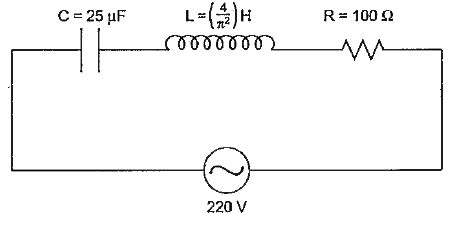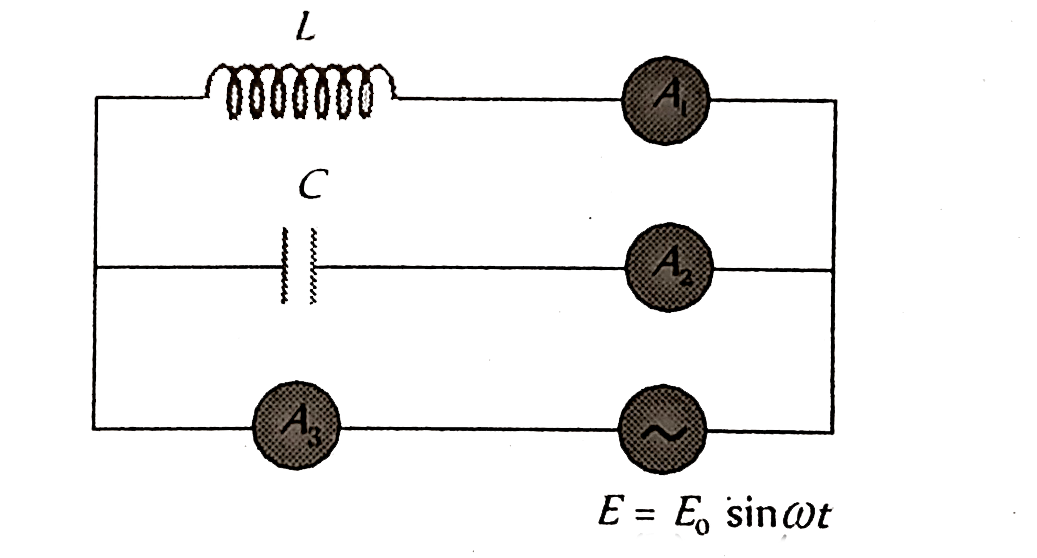A resistor R, an inductor L and a capacitor C are connected in series to an oscillator of frequency n. If the resonant frequency is nr, then the current lags behind voltage, when
n=0
n<nf
n<nr
n>nr
The correct Answer is:D
To solve the problem, we need to analyze the behavior of a series RLC circuit connected to an oscillator and determine under what conditions the current lags behind the voltage.
1. Understanding the Circuit:
- We have a resistor (R), an inductor (L), and a capacitor (C) connected in series to an AC voltage source (oscillator) with frequency n.
- The resonant frequency nr of the circuit is given by the formula:
nr=12π√LC
2. Reactance of Components:
- The inductive reactance XL is given by:
XL=ωL=2πnL
- The capacitive reactance XC is given by:
XC=1ωC=12πnC
3. Condition for Current Lagging Voltage:
- In a series RLC circuit, the current lags behind the voltage when the inductive reactance is greater than the capacitive reactance:
XL>XC
- Substituting the expressions for XL and XC:
2πnL>12πnC
4. Rearranging the Inequality:
- Multiply both sides by 2πnC (assuming n and C are positive):
(2πn)2LC>1
- This can be rearranged to:
n2>14π2LC
5. Expressing in Terms of Resonant Frequency:
- Recognizing that 14π2LC=n2r:
n2>n2r
- Taking the square root of both sides gives:
n>nr
6. Conclusion:
- Therefore, the current lags behind the voltage when the frequency of the oscillator n is greater than the resonant frequency nr:
n>nr
Final Answer:
The current lags behind the voltage when n>nr.
- We have a resistor (R), an inductor (L), and a capacitor (C) connected in series to an AC voltage source (oscillator) with frequency n.
- The resonant frequency nr of the circuit is given by the formula:
nr=12π√LC
- The inductive reactance XL is given by:
XL=ωL=2πnL
- The capacitive reactance XC is given by:
XC=1ωC=12πnC
- In a series RLC circuit, the current lags behind the voltage when the inductive reactance is greater than the capacitive reactance:
XL>XC
- Substituting the expressions for XL and XC:
2πnL>12πnC
- Multiply both sides by 2πnC (assuming n and C are positive):
(2πn)2LC>1
- This can be rearranged to:
n2>14π2LC
- Recognizing that 14π2LC=n2r:
n2>n2r
- Taking the square root of both sides gives:
n>nr
- Therefore, the current lags behind the voltage when the frequency of the oscillator n is greater than the resonant frequency nr:
n>nr
The current lags behind the voltage when n>nr.
Topper's Solved these Questions
- ALTERNATING CURRENTBOOK - CENGAGE PHYSICS ENGLISHCHAPTER - ALTERNATING CURRENTEXERCISE - Comphension Based
8 Videos
- ALTERNATING CURRENTBOOK - CENGAGE PHYSICS ENGLISHCHAPTER - ALTERNATING CURRENTEXERCISE - Single Correct
10 Videos
- ALTERNATING CURRENTBOOK - CENGAGE PHYSICS ENGLISHCHAPTER - ALTERNATING CURRENTEXERCISE - Archives Integer
1 Videos
- ATOMIC PHYSICSBOOK - CENGAGE PHYSICS ENGLISHCHAPTER - ATOMIC PHYSICSEXERCISE - ddp.4.3
15 Videos
Similar Questions
A resistor R,an inductor L, and a capacitor C are connected in series to an oscillator of freqency υ.if the resonant frequency is υr, then the current lags behind voltage, when:
View SolutionFigure below shows a capacitor C, an inductor L and a resistor R, connected in series to an a.c. supply of 220 V.

The resonant frequency of the given RLC circuit.
View SolutionThe frequency of oscillation of current in the indcutor is

View SolutionA resistor R an inductance L and a capacitor C are all connected in series with an ac supply The resistance of R is 16ohm and for the given frequency the inductive reactance of L is 24 ohm and the capacitive reactance of C is 12ohm If the current in the circuit is 5A find
(a) the potential difference across R,L and C
(b) the impedance of the circuit
(c) the voltage of the ac supply and
(d) the phase angle .
View SolutionAn inductance L , a capacitor of 20μF and a resistor of 10Ω are connected in series with an AC source of frequency 50 Hz . If the current is in phase with the voltage, then the inductance of the inductor is
View SolutionAn inductor L and a capacitor C are connected in the circuit as shown in the figure. The frequency of the power supply is equal to the resonant frequency of the circuit. Which ammeter will read zero ampere

View SolutionA capacitor, a resistor and a 40 mH inductor are connected in series to an a.c. source of frequency 60 Hz. Calculate the capacitance of the capacitor,if current is in phase with the voltage.
View SolutionIf a 0.03 H inductor, a 10Ω resistor and a 2μF capacitor are connected in series. At what frequency will they resonate? What will be the phase angle at resonance?
View SolutionA choke coil and capacitor are connected in series and the current through the combination is maximum for AC of frequency n. If they are connected in parallel, at what frequency is the current through the combination minimum?
View SolutionIn a R, L, C circult, three elements is connected in series by an ac source. If frequency is less than resonating frequency then net impedance of the circuit will be
View Solution
